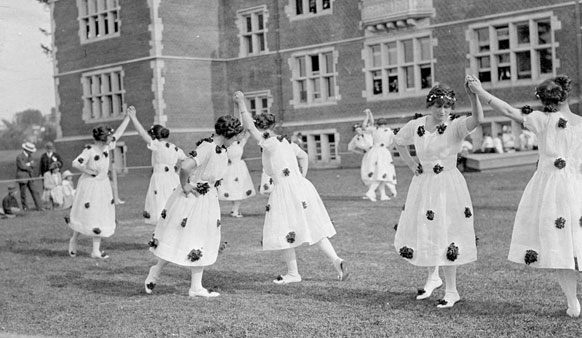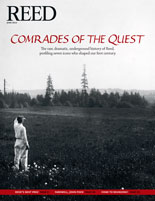
IRIS login | Reed College home Volume 91, No. 2: June 2012
Reunions 2012
Dancing through the Years
By Hannah Kosstrin
Reed dancers have been biologists and chemists, historians and anthropologists, educators and psychologists, musicians, writers, visual artists, choreographers, and performers. Dance has touched the lives of thousands of alumni. Many of them, including Steve Jobs, have pointed to their Reed dance classes as places where they learned creative problem-solving that led them to innovate within their own careers. In these historic photos, you will see dancers' bodies tilt forward and back as their legs bend and extend; arms fly out to the side and grow into wings; heads dip through space; feet triumphantly thrust bodies aloft; dancers share and shift their weight with each other and with sculpture through rolling points of contact. These stunning images speak for themselves, but I will attempt to offer you a quick guided tour of the last hundred years.
There has always been dance at Reed. Starting with the college’s founding, each class’s Maypole team performed a Maypole dance during spring conferences. Other dances performed during this conference were the "Dance of the Cherry Blossoms," wherein one group of women in long rich‐toned tunics, and another in dark puffy‐sleeved bodices over fluffy white taffeta skirts, take turns running in and out of a circle to create the image of a flower. Another processional featured women in full white dresses, twirling white umbrellas, followed by a "Shepherdess Dance," where each participant in her white‐and‐sheer polka dotted dress, complete with panniers, advanced through movement formations carrying a curved, ribboned shepherdess’s staff. That was just the beginning. And my, how far we have come.
Over the past hundred years, the list of visiting artists reads like a who’s who in 20th century dance, and included Charles Weidman, Erick Hawkins, Jean Erdman, Anna Sokolow, Merce Cunningham and John Cage, Armgard von Bardeleben, Danny Lewis, Viola Farber, Nina Weiner, Cathy Weiss, Eiko and Koma, Yvonne Rainer, Trisha Brown, Bebe Miller, Kidd Pivot, Pappa Tarahumara, Collage Dance Theatre, Dawn Stoppiello, Gallim Dance, Anna Halprin, and Susan Leigh Foster, to name a few. Pat Wong, dance professor [1975–2009], reflected how lucky Reed has been that eminent choreographers have wanted to come to our campus to share their work.
One of the exciting things for me as an historian going into the archives to dig up the history of dance at Reed was to find that since the college’s inception, dance at Reed has followed progressive trends in the larger world of contemporary dance. Starting in the 1910s, when the college put up pageants such as Antigone, students took classes in movement techniques such as American Delsartism, which taught women stylized gestures and poses through which to express specific emotions. As was customary nationwide at the time with the craze of aesthetic dancing, there are also pictures of women in dark bloomers and white sailor’s blouses performing various poses and calisthenics outside. This also was the Ragtime era and dance cards [1914–15], in soft Reed‐maroon‐colored velour cases, secured with a ribbon, listed one steps, two steps, and waltzes, at the school dances. Through the next hundred years, Reed dancers learned the techniques and choreography, and read the theory, of prominent and cutting‐edge choreographers and scholars.
From the late 1940s through the 1950s, a group of women affiliated with Reed—some taught at Reed, and some were professional dancers in Portland who had danced in New York—formed the Reed College Dance Events Committee. They gave modern dance classes in what was then Botsford Hall, a multipurpose building with a performance space on one end (on the other end of campus), and brought in guest artists to give master classes and to perform. The first master class was in 1948 with Charles Weidman, a prominent choreographer of the early modern dance generation who danced at Denishawn, created his own technique, and was artistic partners with Doris Humphrey in the Humphrey‐Weidman Company. This was the beginning of Reed’s 25‐year relationship with Weidman. He came many times as a guest artist; Judy Massee, dance director [1968–96], danced in his work and taught classes in his technique; and he gifted Reed the rights to perform Lynchtown, one of his most famous works. Other guest artists from the 1950s featured on the wall include Richard Ford and Georgiana Wiebenson, who jump up from the sand amidst a California‐coast sea breeze in 1952.
All this time, dance was housed in the PE department, with dance professors including Josephine Hammond [1910s], Elizabeth Carter [1946–49], Colleen Cooke [1949–53], Marguerite Dodds‐Belanger [1953–62], and Trisha Brown [1958–60], who went on to become one of the leaders of experimental post‐modern dance, and who was responsible for getting Dance 110 for academic credit in the Division of the Arts in the 1959–1960 school year. Elfi Hosman [1963–68], who began at Reed the year dance became its own department within the Division of the Arts, created Dance 210 and 310 for academic credit. Judy Massee began teaching at Reed in 1968. In the ensuing years, she developed a 400‐level independent study, as well as a dance history course, and ballet class, and she advised theses and taught courses in the MALS program. The interdisciplinary dance‐theatre major was established in 1975, the same year that Patricia Wong joined the dance faculty at half time. In 2002, Wong was the first dance faculty member at Reed to get tenure. Carla Mann ’81 joined the dance faculty in 1995, followed by Minh Tran in 2008 and Hannah Kosstrin in 2010.
In 1973–83, Reed hosted the Reed College Summer Dance Workshop, aka the Northwest Summer Dance Workshop, one of the largest summer dance festivals in the Pacific Northwest, which brought students and guest artist teachers from all over the country together to teach and take classes in modern dance (including Martha Graham and Charles Weidman techniques), jazz dance, ballet, African dance, and stretch and placement for dancers. Weeknight dance history lectures complemented the daytime activities. At its peak in 1979, the five–week workshop boasted 500 students, a faculty of 12, and 10 skilled accompanists. Classes took place all over campus, and Massee remembers going up into the balcony of the SU and looking down with excitement on the full ballet class below. This past spring, Reed Arts Week brought in an experimental dance work by choreographer Kathy Westwater, and filled the SU with dance once again.
One of the central aspects of the Reed dance program has always been a marriage of theory and practice. This means not just learning about the history of certain dances, but also learning those dances in the studio in order to embody them and understand the work from the inside out. One such project was in 2003, when leading post‐modern choreographer Yvonne Rainer came to Portland to coach professional dancers Linda K. Johnson and Shelley Senter in her iconic post‐modern anthem Trio A. Reed offered Rainer studio space for rehearsal, and as a result, Reed students were able to observe them working, to see Rainer coach Johnson and Senter, and to learn part of the dance and perform it on the spring dance concert that year. Trisha Brown has returned to campus several times, both with her company, Trisha Brown Dance Company, and to give lectures. In the mid-1980s, Brown’s dancers performed her influential piece Walking on the Walls in the gym, though, as Wong remembered, without the ropes or harnesses, with some dancers holding up the walkers from underneath.
In recent years, Reed dance has collaborated with White Bird, Portland’s dance presenting organization, as well as with the Portland Institute of Contemporary Art, for master classes and workshops. In 2004, Reed held a multi‐institutional workshop, performance, and symposium on collaboration in conjunction with the Merce Cunningham Dance Company’s 50th anniversary celebration. Professional and student dancers, musicians, and visual artists from Reed, Lewis & Clark College, and the University of Oregon created a large-scale piece in the collaborative spirit of Merce Cunningham, John Cage, and Robert Rauschenberg.
The dance department has grown to offer technique classes in modern dance, Balinese dance, improvisation, and Southeast Asian dance; theoretical classes in dance histories of the U.S., Latin America, Europe, and Southeast Asia, along with cultural studies, composition, site‐specific dance, dance technology, and Labanotation. The folk dance tradition, which Pearl Atkinson began 50 years ago, continues, and also through the PE department we have classes in African dance, ballet, ballroom dance, bellydance, capoeira, hip hop, and jazz.
And it just keeps getting better. The new Performing Arts Building will include a state-of‐the‐art dance studio and a shared performance space. Also, in partnership with computer user services (and as of September 2011, with the support of the National Endowment for the Humanities Office of Digital Humanities), we are developing an app for the iPad that is a new version of LabanWriter, the computer program that writes Labanotation. And Reed students, the heart and soul of Reed dance for 100 years, continue to do amazing things.
This essay is adapted from a lecture Hannah gave at Reunions 2011. Thank you to Gay Walker and the Reed College Archives for their assistance with archival materials. Collections consulted include academic departments, campus events, general files, Reed Oral History Project, photographic files, and 1910s scrapbooks. Thank you also to Pat Wong, Judy Massee, and Carla Mann for sharing their memories of the Reed dance program. Thank you to Amy Lindsay, Brynna Hurwitz, Lisa Gillette, and Peter Abrahms for organizing the dance events at Reunions 2011, and to Stephanie Snyder for curating the 100 Years, 100 Images of Dance exhibit.



LATEST COMMENTS
steve-jobs-1976 I knew Steve Jobs when he was on the second floor of Quincy. (Fall...
Utnapishtim - 2 weeks ago
Prof. Mason Drukman [political science 1964–70] This is gold, pure gold. God bless, Prof. Drukman.
puredog - 1 month ago
virginia-davis-1965 Such a good friend & compatriot in the day of Satyricon...
czarchasm - 4 months ago
John Peara Baba 1990 John died of a broken heart from losing his mom and then his...
kodachrome - 7 months ago
Carol Sawyer 1962 Who wrote this obit? I'm writing something about Carol Sawyer...
MsLaurie Pepper - 8 months ago
William W. Wissman MAT 1969 ...and THREE sisters. Sabra, the oldest, Mary, the middle, and...
riclf - 10 months ago